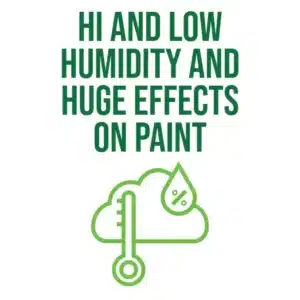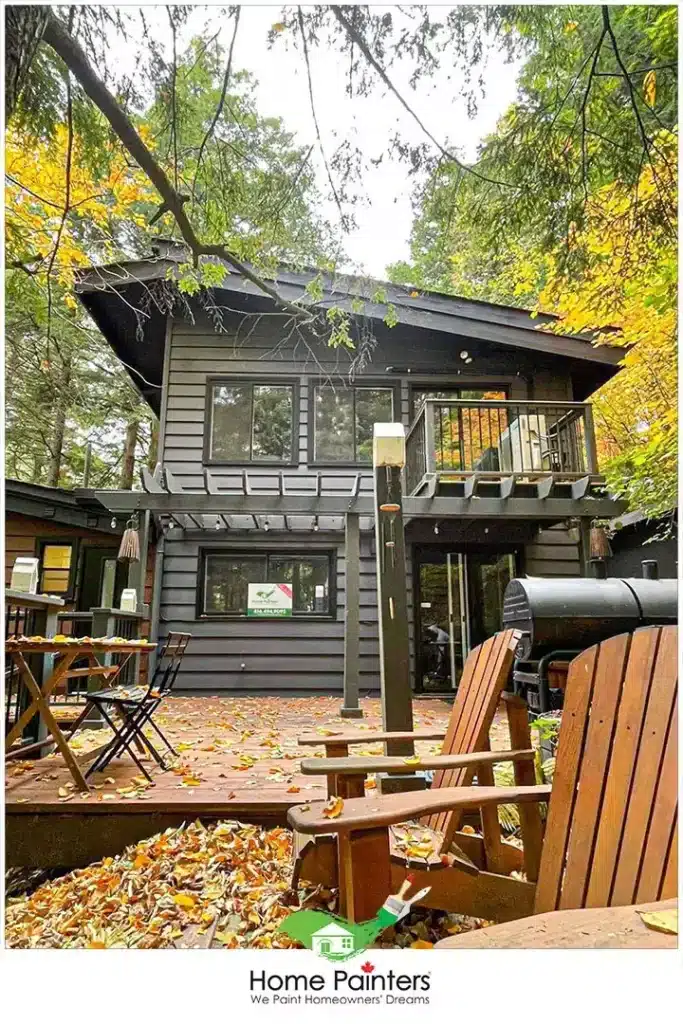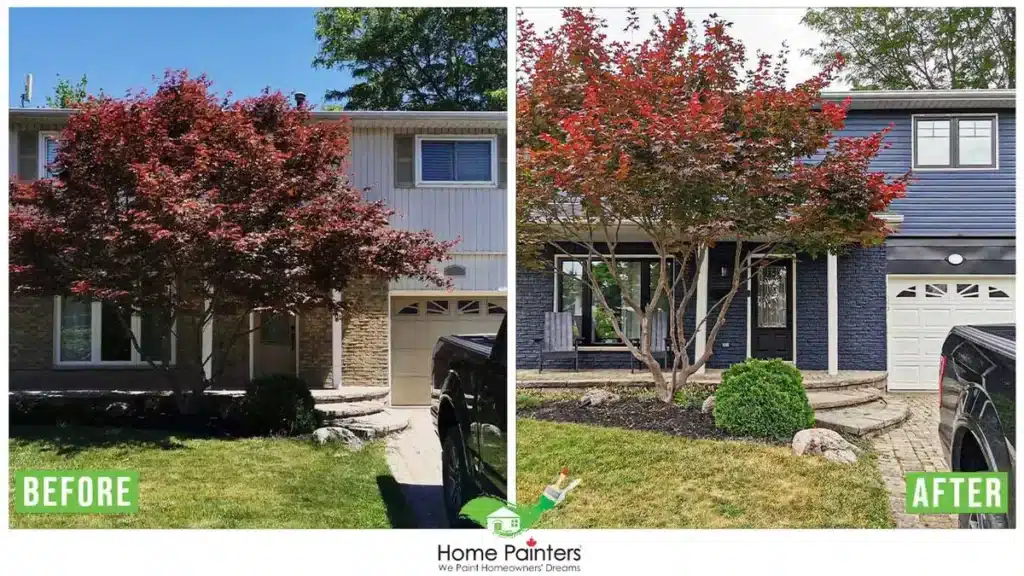
Weather Affects Paint
Before you set a date for your renovation, here are some critical weather facts to remember before you start painting your home:
Painting your house costs thousands of dollars, so don’t forget the effects of weather on paint.
The effects of weather can damage your paint. So, if you want your investment to last as long as possible, choose the right weather to paint your house. It will go a long way toward protecting your home and your money.
How Does Weather Affect Painting Quality?
Sunlight and UV Radiation Affect Paint Job
A beautiful sunny day might be great for spending the day outside, but it can cause premature paint failure. Direct sunlight, especially when it’s extremely hot, deteriorates the binding agents and pigments of paint. Thus, the effects of paint on the environment where it is applied should be considered. Since they can break down chemical bonds and fade the colour of an object. Ultraviolet rays are one of the primary causes of fading among paints.
But then, for any ultraviolet radiation to modify paint colour, it must be absorbed by the paint itself. This causes chalking, fading and erosion. Certain paints, like acrylic paints, are sluggish to soak up ultraviolet rays and thus much slower to dry up and lose colour. Low-quality paints are more susceptible to sunlight as well.
Water and Moisture
What happens to paint when it rains?
It’s no brainier that you don’t want to paint when it’s raining. Wet surfaces and rainy days are the perfect matches to consider when not to paint outside. Rains and winds can easily wipe out the wet paint. Most likely, the paint will not stick to the walls due to its wetness. And if the paint does not get adequate time to dry before the rain starts, it will just be washed out easily in a matter of minutes. One of the best methods to avoid any of these catastrophic events is by ensuring to avoid rainy days when painting home exteriors. If the weather forecast anticipates rain for the next couple of days, it would be best to reschedule your painting project for another time.
If you reside in a seaside area or in a place where heavy rainfall is a normal phenomenon. You might want to consider using weather-proof paints or get the best paint for cold weather and see it as a worthwhile investment. Although the paint might take more time to dry, it will guarantee that your exterior walls are protected from heavy rains and the paint does not fade. And lose its colour throughout the years. But even after the rain is gone, you need to make sure that the surfaces hit by rain are given enough time to properly dry out before applying paint. Failure to do so can result in cracking, blistering and flaking, especially on permeable surfaces like wood.
High and Low Humidity and Huge Effects on Paint
When it’s sticky and humid outside like a typical Toronto summer day, it will take your paint a lot longer to dry. When the humidity levels are high, the moisture in the paint takes much longer to escape. This results in poor adhesion and a shorter lifespan. In addition, remember that paint has protective qualities that can end up being compromised. And considering what paint is good for high humidity is a must. In low humidity, the dry air pulls the moisture out of the paint too quickly. This rapid drying doesn’t allow the paint to stick properly and again results in poor durability.
Humidity is high
Wood surfaces are indeed problematic, as the wood can absorb wetness from the air. And when the paint is applied to the surface, the moisture in the wood might cause it to bubble. It can significantly affect the paint’s ability to stick to the wood. The paint can peel and bubble when the wood is not dry enough. Thus, it is important to note which type of paint should not be applied during damp and humid weather.
Wood surface areas are particularly bothersome when the humidity is high, as the wood can take in all the moisture from the air. When the paint is used to the surface area, the moisture in the wood can trigger it to bubble and affect the paint’s ability to stick to the wood. If you’re wondering, does humidity affect oil-based paint? The short answer is yes, which applies to water or oil-based paints and even applies to painting metal in high humidity.
Surely, if you have ever attempted to dry wet clothes on a humid day, you will know how tough it is for wetness to vaporize on such days. The same concept applies to painting. You’ll know how humidity affects painting indoors and outdoors. You’ll also know how to dry paint in high humidity and how challenging it might be. Because the water in the paint does not evaporate easily in high humidity. The moisture in the air makes it hard for the paint to dry totally.
Lower temperatures in high-humidity weather.
When the paint is applied at lower temperatures in high-humidity weather, condensation might happen on the surface of the paint. This is the perfect combo for catastrophic problems. When condensation affects the paint surface area, it ends up being damaged. The paint may lift, it might not stick well, and there can be a failure of overpainting, which can lead to another problem. Thus, it is better to choose the best exterior paint for high humidity to save you time!


Too Cold
When it’s cold outside, paints get thicker and are harder to apply. Drying also takes much longer making it difficult for the paint to bond to surfaces. Paint requires several days to settle, and as the temperature dips down to negative, dew can form on surfaces and cause the water in the paint to vaporize too gradually. That affects how the paint holds up with time and how well it resists breaking.
Colder temperature levels and surface area wetness can result in staining or mildew, so better to get a cold-weather paint additive that is resistant. This affects paint jobs and results in cracking and chalking.
Too Hot
What temperature is too hot to paint outside? It depends on the paint. Most paints have a working temperature range, and if they get above that, they can start to degrade. The same goes for UV light: while it might not be so bad in short bursts, prolonged exposure can cause issues too.
Hot weather causes paint to dry much too fast. When the weather is too hot, particularly in direct sunlight, the paint dries before it can totally bind, leading to peelings and severe crackings, especially in the long run. This not only affects the overall lifespan but also makes applying the paint more difficult.
Paint that dries too fast is hard to spread and clogs up brushes and rollers. For latex paint drying temperature, direct sun on hot days at levels above 85 degrees might dry the paint prior to it being appropriately brushed out.
Planning your next project
So before you plan your next painting project, keep the weather in mind. Remember how weather affects paint?
You may be wondering now, what is the best temperature to paint inside and what is the best time to paint outside? It depends on what you’re painting. Follow these guidelines to ensure you get the most value and the longest life out of your paint.
- 1. Does your laundry take a long time to dry outside? If so, so will your paint.
- 2. Don’t paint in super hot weather or direct sunlight. Paint on the shaded sides first, or start ahead of the sun and adjust your painting as the sun moves above.
- 3. Does water spit on concrete take a long time to dry? If yes, leave your painting for another day. A light breeze is ideal for properly drying paint. If it’s too windy you can concentrate on sheltered sides of your home until conditions improve.
- 4. Overcast and cloudy days are the best for painting.
- 5. Overall, the ideal conditions are 15-20°C, 70-80% humidity, and a gentle breeze.

While these are the ideal conditions for house painting, it doesn’t mean you can’t paint when the conditions are less than ideal. But you need to know how.
- Paint thinners can be added to adjust for weather and paints designed specifically to counter changing weather conditions can be used when a job needs to get done. It can decrease the effects of weather on a paint job. This, however, requires a lot of knowledge and experience and is likely a job best left to the professionals.
- Whether (no pun intended) the conditions are ideal for house painting or not, a reputable and experienced painter in Toronto and the GTA knows how to manage weather conditions and ensure that you get the longest and most durable lifespan from your paint. Remember, a poor paint job will last but a few years, while a professionally painted home will look great for a decade or more with fewer effects of weather on the paint.
- With over 35 years of experience in the painting business, Home Painters Toronto knows how to tackle any painting project and get it done right the first time.
- That’s why we confidently provide a 100% Satisfaction Guarantee and all our work comes with an unmatched Two-Year Quality Guarantee.
- We use only the top quality paints such as Behr, Dulux and Benjamin Moore and you can verify our high standards on HomeStars.com where we are a Top-Rated house painting company in Toronto.
Most Interesting Blogs Related to
“The Effects of Weather on Paint”
Don’t hesitate to call us! We will help you pick the colours you want and show you the latest painting and home renovation trends. Our home painting services with the best pro painters have been around now for over 36 years.
Call 416.494.9095 or email [email protected] for a FREE quote for your home painting needs. And don’t forget to check us out on our social media channels below!





